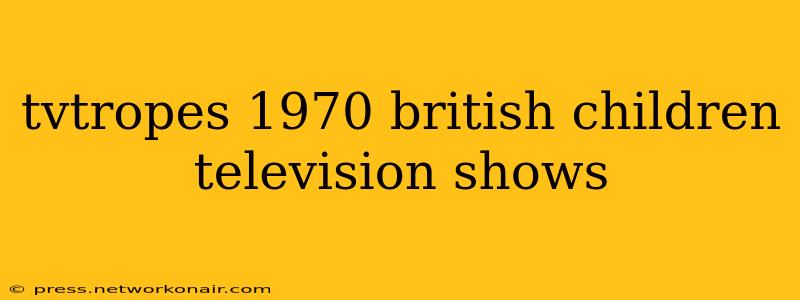The 1970s in Britain saw a golden age of children's television, a vibrant tapestry woven with whimsical puppet shows, adventurous serials, and educational programs that captivated a generation. While many shows may be obscure now, their influence on future programming remains undeniable. This exploration delves into the unique characteristics of 1970s British children's television, examining its enduring legacy and answering some frequently asked questions.
What were some popular 1970s British children's TV shows?
The decade boasted an incredibly diverse range of programming. Some of the most fondly remembered include:
- Play School: A cornerstone of preschool television, Play School used simple storytelling, songs, and crafts to engage young viewers. Its gentle pace and focus on interaction remain influential in early years programming today.
- Rainbow: Featuring the iconic Geoffrey Hayes, Rainbow was a colourful mix of puppets, songs, and sketches. Zippy and George, the show's zany puppets, are still instantly recognizable to many.
- Tiswas: A more anarchic and unconventional offering, Tiswas blended slapstick comedy, music, and audience participation. Its chaotic energy appealed to older children and even attracted adult viewers.
- The Wombles: These endearing, rubbish-collecting creatures captured the hearts of a nation with their environmental message and catchy theme tune. Their adventures resonated with children's natural curiosity about the world around them.
- Rentaghost: This supernatural sitcom featured a team of friendly ghosts working for a rental agency, dealing with everyday problems with a comedic twist. Its blend of humour and the fantastical appealed to a broad age range.
What made 1970s British children's TV unique?
Several factors contributed to the distinctive character of 1970s British children's television:
- A focus on creativity and imagination: Many shows prioritized imaginative storytelling and allowed for a degree of silliness and absurdity, encouraging children's creativity.
- Simple yet effective production values: While special effects were limited by the technology of the time, the shows often compensated with clever writing, strong characters, and memorable music.
- A sense of national identity: Many shows reflected British culture and humour, creating a sense of shared experience for young viewers.
- Educational value: While entertaining, many programs incorporated educational elements, subtly teaching children about the world around them.
What kind of themes were explored in 1970s British children’s TV?
The shows covered a range of themes, often reflecting the social and cultural climate of the time:
- Environmentalism: Shows like The Wombles promoted environmental consciousness, highlighting the importance of recycling and respecting nature.
- Friendship and cooperation: Many shows emphasized the value of teamwork, friendship, and helping others.
- Social issues: Some programs subtly tackled social issues relevant to children, such as dealing with loss or adjusting to change.
- Fantasy and adventure: A significant amount of programming embraced fantasy and adventure, transporting children to magical worlds and exciting escapades.
How did 1970s British children's TV influence later programming?
The influence of 1970s British children's television can be seen in many contemporary shows:
- The enduring appeal of puppets: The success of shows like Rainbow and The Wombles helped establish the enduring popularity of puppet shows in children's programming.
- The importance of imaginative storytelling: The emphasis on creativity and imagination in 1970s shows continues to inspire children's television today.
- The integration of education and entertainment: The blending of educational content with entertainment remains a key element in many modern children's programs.
The 1970s British children's television landscape was a fertile ground for creativity and innovation, leaving behind a legacy that continues to resonate with viewers today. These shows, with their unique blend of charm, imagination, and educational value, remain a testament to a golden age of children's programming. While technology has advanced significantly, the core principles of engaging young minds with creative and imaginative content remain as relevant as ever.

